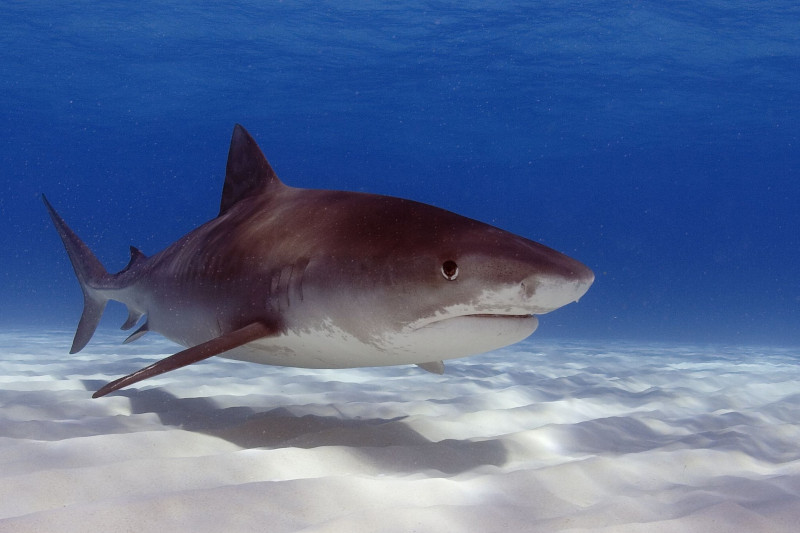
Tiger Shark Facts
- This majestic product of Nature and evolution most frequently goes by the attention-grabbing common name of the Tiger Shark. Yet, the marvel of Nature has other general titles, as well. These include such terms as spotted shark and leopard shark, just to name a few.
- Within the community of scientific professionals, however, it’s possibly much better known by another one. That’s its technical moniker. Unfortunately, though, that’s a somewhat difficult one for the layperson to pronounce. It holds the official tag of Galeocerdo cuvier.
- The impressive animal received that tongue-twisting epithet after to the actions of the duo of François Auguste Péron and Charles Alexandre Lesueur. The two French naturalists achieved the first recognition of the creature as a separate and distinct species in the year 1822.
- Yet, that was not the name these researchers applied to it. They named the fish Squalus cuvier. Subsequently, later actions changed its designation several times. In 1837, another team assigned it the tag Galeocerdo tigrinus. But, it eventually received its current label.
- Unfortunately, the amazing Tiger Shark presently finds itself in dire straits. Its population base appears to be dwindling rapidly. Regrettably, that state seems to hold true across its entire range. The IUCN thus presently lists the animal as Near Threatened on its Red List.
- It’s currently facing serveral threats to its continued existence as a species. Like other species, most of these dangers stem from the actions of man. It faces the perils of commercial fishing practices, for one. It’s also now facing the dangers posed by habitat loss and climate change.
Related Articles
Tiger Shark Physical Description
The fascinating Tiger Shark fully merits the appreciation and respect it’s shown by those who encounter this amazing fish. Unlike some relatives, however, it does so not only because of its intriguing apperance. This creature also reaches highly respectable physical dimensions.
In that regard, though, it does maintain the pattern common among its many relatives. That’s due to the fact that the shark displays a certain degree of the physiological characteristic of sexual dimorphism. Yet, in its particular case this evolutionary trait manifests itself solely in terms of size.
More specifically, females of the species attain greater average measurements than their male counterparts. Mature females reach mean lengths of approximately 12.2 ft (3.7 m). Exceptional specimens exist, however. Confirmed examples sometimes grow up to 16.4 ft (5 m).
Weights of females also average greater than males, sometimes significantly so. Exceptional specimens of this sex occasionally exceed the extraordinary mass of as much as 2,900 lb (1,315 kg). Few individuals ever reach this great of a size, though, with most known specimens being smaller.
Males of the remarkable animal, meanwhile, remain somewhat smaller, sometimes much more so. For them, a typical body length measures around 10 ft (3 m). Rarely, an individual exceeds this size, but not greatly. Reliably confirmed reports puts the longest known male at 13.1 ft (4 m).
Since their lengths remain less, it’s only natural that the weight of this gender also measures less. For them, a mean body mass ranges from between 1,200 – 1,400 lb (544 – 635 kg). Naturally, a few exceptional examples do manage to grow beyond this size, but rarely by very much.
Otherwise, the genders of the impressive Tiger Shark present the same general appearance. Above, the overall color scheme generally consists of various shades of either light green or blue. Underneath, however, various shades of a pale yellow predominate, and rarely an off-white hue.
- Kingdom: Animalia
- Phylum: Chordata
- Class: Chondrichthyes
- Order: Carcharhiniformes
- Family: Galeocerdonidae
- Genus: Galeocerdo
- Species: G. cuvier
Tiger Shark Distribution, Habitat, and Ecology
The amazing Tiger Shark evolved as native to a comparatively broad expanse of the marine regions of the globe. The full extent of that zone habitation might surprise you, though. That’s because this wonder currently appears in nearly all of temperate and tropical waters around the world.
The exception to this pattern of habitation remains its lack of presence in the Mediterranean Sea. A few areas of the world do seem to show greater presences, however. Some of these include the Caribbean Sea, the Gulf of Mexico, and offshore of Australia, Indonesia, China, Africa, and India.
Yet, within that vast expanse of numereous seas and oceans, this true biological marvel displays a distinct preference regarding its choice of habitat. That’s true since the fish mainly, though, not exclusively appears relatively close to the coastline. It even approaches the shore after prey.
Even when it does appear somewhat near the shore, however, it generally prefers relatively deep waters. These regions also typically coincide with the presence of reef systems. Although the animal usually stays at relatively moderate levels, it’s been spotted at depths up to 3,000 ft (914 m).
The Tiger Shark feeds as one the apex predators of the oceans. It’s not a selective hunter, though, with a reputation for eating virtually anything. Though its diet principally consists of fish, it also consumes many crustaceans, sea snakes, seabirds, seals, and numerous others.
Given its significant size and power, this majestic denizen of the depths itself has very few natural predators. In fact, the only confirmed natural foe the animal faces in this respect is the Orca. Outside of such fates, it’s not known with any certainty how long the species lives.
Species Sharing Its Range
Check out our other articles on 5 Terrific United States Trees, Eastern Gray Squirrel, Lake Atitlan, Indigo Milk Cap, Indian Vulture, East African Lowland Honey Bee, Jamaican Iguana
